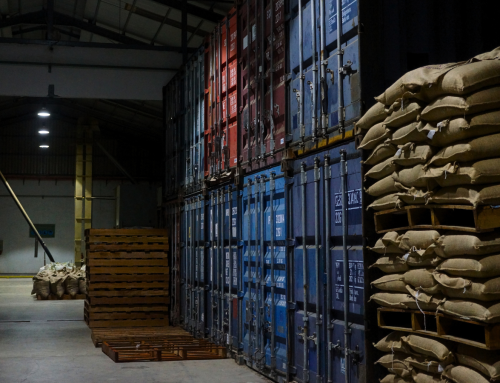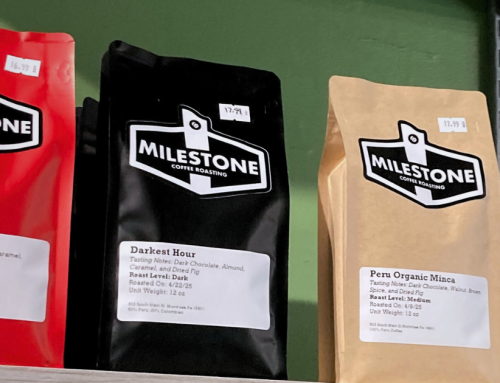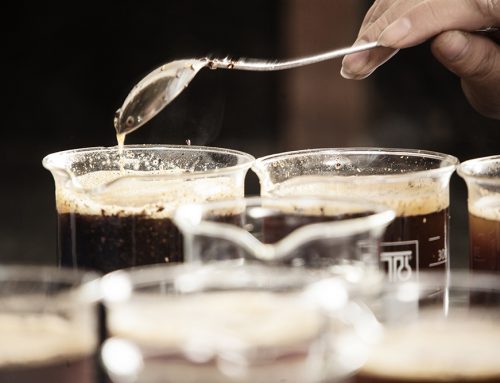Coffee Roasters are ever curious about coffee, so the Genuine Origin team is constantly fielding questions. But one topic that comes up often is: blending coffee. Coffee blends have probably been around as long as roasting coffee. Why? Because blending two or more coffees together invites opportunities for self-expression, new flavor combinations, and adds versatility when operating a roastery.
As an experienced roaster myself, I have a good deal of hands-on experience developing blends. Blending is a common practice for roasters. Simply put, blending happens whenever a roaster combines any number of different coffees together. These coffees can have different origins, processing methods, or any other distinguishing features. The blending process can be done before or after the roast. Finally, a roaster’s blends can be where they truly differentiate themselves.

Coffee roasting checking roast level Img by RyanJLane from Getty Images Signature
Why do roasters blend?
Blending can be done for a variety of reasons. Here are some common ones:
- Trying to create a unique flavor profile using coffees with different origins or characteristics
- Creating a coffee that is consistent to your brand across all seasons
- Efficient way to use aging or less popular green inventory
Let’s start with the two common ways that roasters blend.

Fresh roasted coffee in a cooling tray. Img credit – MichaelL from Getty Images
Pre-Blending
Pre-blending is the process of blending the green before the coffee goes into the roaster. This can save a lot of time on production, but there’s a couple things of which a roaster should be aware. When pre-blending, you can weigh out the coffee and throw it into the roaster altogether, but due to the varying moisture content, and physical characteristics of each green coffee, there’s a chance that the different coffee types are having entirely different experiences inside of the roasting drum / chamber.
The upside of pre-blending is the time you save in production. The downside is having coffee in the cooling tray with variability in roast level. Some coffee will be perfectly developed, while others will be too light or dark. You can prevent this by pre-blending green coffees in 24 hours+ ahead of the time they will be roasted. This allows for the coffees to sit together and for the moisture content to homogenize.
It’s also easier to ensure roast consistency if you’re blending coffees which are similar in bean size and processing method. The biggest downside to pre-blending is that, once the coffee comes out of the roaster, it’s already blended and there’s not much you can do to change how it tastes – aside from even more blending and experimentation.

Blending fresh roasted coffee in bins. Img by hsyncoban from Getty Images Signature
Post Roast Blending
Post-roast blending is simple: you roast each component green coffee from your blend on its own. Each coffee gets roasted exactly the way you want it, allowing you to optimize the development of each coffee before it goes into the blend. The post-roast method is my personal favorite when blending. It allows me to experiment with different blend percentages and ratios. You can improve upon or capture the flavors you are seeking by simply adding different coffees together. When deciding on the percentage of each blend component, set up a cupping table. I used this example in our Roasting/Blending for Espresso article:
- Cup 1 is 25% Colombia, 75% Ethiopia.
- Cup 2 is 50% Colombia, 50% Ethiopia
- Cup 3 is 25% Colombia, 75% Ethiopia
This way, you can taste through the different blends and see which components work best. Ask yourself questions about your blend. What flavors are shining through? Is everything balanced?
Another way to test out potential blends is by setting up a cup for each individual coffee. Following cupping protocols, spoon a little bit of one component into another cup. Be sure to keep track of the blend ratio you use. This way, you have the coffees all extracting on their own, which you can then combine yourself.
- Cup 1 is Ethiopia
- Cup 2 is Colombia
- Cup 3 is Honduras
Go through and take a few spoonful of each into your cup and create a blend that is ⅓ of each of these coffees. Taste your sample and repeat with varying amounts to find the blend that suits you.

The Q-grading team at Molinos de Honduras cupping coffee
Being Intentional
It’s important to ask yourself why you’re blending, or whether you actually need to do it. My personal preference in a roasting environment is to keep things simple. The last thing you want to do is create extra work for yourself and end up wasting coffee and time.
When choosing coffees to blend, it is important to be intentional. Arbitrarily adding too many different coffees when blending can lead to issues with solubility. When I say solubility, I’m talking about the rate in which a coffee allows for water to extract the flavor compounds present in each coffee bean.
Different coffees have naturally varying degrees of solubility due to origin, roast degree, and other factors. If you’re blending coffees together that do not extract at the same rate, this can become problematic. You could wind up with a blend that tastes both bitter and sour at the same time due to one coffee being over extracted, and the other being under extracted. Many roasters can taste this if you experiment by making a black & tan type blend (light and dark roasts mixed), or if you combine too many different coffees from varying origins.

Genuine Origin cupping tray, custom Akiva cupping spoon & roasted coffee beans
Choosing Coffees to Blend
A roaster can blend coffees for any and all of the reasons mentioned above. If you think it would be a good branding and marketing idea to develop a year round house blend, work on finding coffees with target flavor notes that are replaceable throughout the year. The same thing goes for seasonal blend creation. Be as creative as you’d like!
Blending can also be very useful as a tool when coffees begin to age. Green coffee, stored well, lasts a long time. But, if you feel that a coffee is aging and no longer tasting like the best version of itself, it’s a great idea to try to improve it by blending it to lift the quality. This is a great way to exhaust the stock of the coffee that is taking up space in your inventory, and get it out the door to happy coffee drinking customers!

Fresh roasted coffee beans – Img by Creative Credit from Getty Images
A Quick, Baseline Guide for Blend Creation
Always think about what characteristics the coffees have and how they will impact one another. If you have a mild Brazil as a base, consider adding a natural Ethiopia to it. Do it right and you’ll get a coffee that is nice and chocolatey, nutty, but has the ripe fruitiness from the natural Ethiopia. This combination enhances the Brazil, while toning down the intensity of the Ethiopia. Here are some ideas:
Classic House Blends: chocolatey, caramel, nutty, notes of citrus on top, dried fruit
Origins: Colombia, Honduras, Mexico, Guatemala, Brazil for base notes, Ethiopia for acidity
Process: used washed coffees or Semi washed from Brazil
Adventurous House Blend: heavier bodied, blackberry, raspberry, milk chocolate
Origins: Honduras, Colombia, Brazil for base notes, Natural or Honey processed for acidity
Process: use any processes necessary
Classic Espresso Blend: chocolatey, caramel, nougat, full bodied
Origins: Colombia, Honduras, Guatemala, Brazil, Sumatra, Peru
Process: Washed coffees
Adventurous Espresso Blend: chocolatey, cherry, jammy or tropical and funky
Origins: naturally or experimentally processed coffees from anywhere mixed with milder washed coffees from Brazil, Honduras, Guatemala or Colombia
Process: the wilder the better!
Summary
Remember, blends can be where your show who you are as a roaster. You can differentiate your roasting business and create an infinite number of coffee combinations. While this article serves as a jumping off point, you should also look at what other roasters are doing. Check the contents of blends from popular roasters you enjoy. Most roasters will disclose the origins they use in their blends on the bag. Finally, the coffee is there for you to roast and enjoy. So, start experimenting with blends and make it happen.






